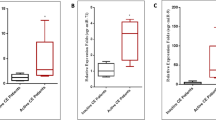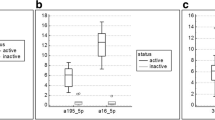Abstract
Introduction
Cystic echinococcosis (CE) is a neglected tropical disease caused by the larval stages of Echinococcus granulosus (E. granulosus). MicroRNAs (miRNAs) are small noncoding RNAs acting as mediators in host-parasite interaction. Recently, numerous studies have been conducted on miRNAs in infectious diseases; however, little data are available about the role of miRNAs in pathogenesis and early diagnosis of CE.
Methods
The current study evaluated the expression of four E. granulosus-derived miRNAs, including egr-miR-125,5p, egr-let-7,5p, egr-miR-2, and egr-miR-71 in fibrotic and healthy liver tissues of 31 CE patients with active and inactive hydatid cysts by qRT-PCR.
Results
Of the 31 patients, 48.4% had active cysts (CE1 and CE2), while the remainder had transitional (16.1%) and inactive (35.5%) CE types cysts. The qRT-PCR analysis revealed a significant increase of 11.2, 9.91, 6.2, and 13.1-fold in the fibrotic tissue group for egr-miR-125,5p, egr-let-7,5p, egr-miR-2, and egr-miR-71, respectively. Among these miRNAs, egr-miR-125-5p exhibited the highest area under the curve (AUC) value of 0.8050 for predicting liver fibrosis.
Conclusions
Our findings provide new data about the role of E. granulosus-derived miRNAs in pathogenesis of CE. The high AUC of egr-miR125,5p reflecting the possibility of using egr-miR125,5p as biomarker in CE diagnosis. Further studies on serum of CE patients are needed to confirm the potential role of circulating egr-miR-2a-3p and egr-miR-125-5p in the early diagnosis of CE.








Similar content being viewed by others
Data Availability
All data generated or analyzed during the current study are included in the paper.
References
Mariconti M, Vola A, Manciulli T, Genco F, Lissandrin R, Meroni V, Rosenzvit M, Tamarozzi F, Brunetti E (2019) Role of microRNAs in host defense against Echinococcus granulosus infection: a preliminary assessment. Immunol Res 67(1):93–97. https://doi.org/10.1007/s12026-018-9041-4
Kalifu B, Maitiseyiti A, Ge X, Chen X, Meng Y (2021) Expression profile of circular RNAs in cystic echinococcosis pericystic tissue. J Clin Lab Anal 35(3):e23687–e23687. https://doi.org/10.1002/jcla.23687
Díaz Á (2017) Immunology of cystic echinococcosis (hydatid disease). Br Med Bull 124(1):121–133. https://doi.org/10.1093/bmb/ldx033
Anthony B, Allen JT, Li YS, McManus DP (2010) Hepatic stellate cells and parasite-induced liver fibrosis. Parasit Vectors 3(1):60. https://doi.org/10.1186/1756-3305-3-60
Zhang C, Wang L, Ali T, Li L, Bi X, Wang J, Lü G, Shao Y, Vuitton DA, Wen H, Lin R (2016) Hydatid cyst fluid promotes peri-cystic fibrosis in cystic echinococcosis by suppressing miR-19 expression. Parasit Vectors 9(1):278. https://doi.org/10.1186/s13071-016-1562-x
Li G, Li J, Li C, Qi H, Dong P, Zheng J, Yu F (2016) MicroRNA-125a-5p contributes to hepatic stellate cell activation through targeting FIH1. Cellular Physiol Biochem 38(4):1544–1552. https://doi.org/10.1159/000443095
Szabo G, Bala S (2013) MicroRNAs in liver disease. Nat Rev Gastroenterol Hepatol 10(9):542–552. https://doi.org/10.1038/nrgastro.2013.87
Brunetti E, Tamarozzi F, Macpherson C, Filice C, Piontek MS, Kabaalioglu A, Dong Y, Atkinson N, Richter J, Schreiber-Dietrich D (2018) Ultrasound and cystic echinococcosis. Ultrasound Int Open 4(03):E70–E78
Pedrosa I, Saíz A, Arrazola J, Ferreirós J, Pedrosa CS (2000) Hydatid disease: radiologic and pathologic features and complications. Radiographics 20(3):795–817. https://doi.org/10.1148/radiographics.20.3.g00ma06795
Velasco-Tirado V, Romero-Alegría Á, Belhassen-García M, Alonso-Sardón M, Esteban-Velasco C, López-Bernús A, Carpio-Perez A, Jimenez López MF, Muñoz Bellido JL, Muro A, Cordero-Sanchez M, Pardo-Lledias J, Muñoz-Bellvis L (2017) Recurrence of cystic echinococcosis in an endemic area: a retrospective study. BMC Infect Dis 17(1):455. https://doi.org/10.1186/s12879-017-2556-9
Alizadeh Z, Mahami-Oskouei M, Spotin A, Kazemi T, Ahmadpour E, Cai P, Shanehbandi D, Shekari N (2020) Parasite-derived microRNAs in plasma as novel promising biomarkers for the early detection of hydatid cyst infection and post-surgery follow-up. Acta trop 202:105255
Örsten S, Baysal İ, Yabanoglu-Ciftci S, Ciftci T, Ünal E, Akıncı D, Akyön Y, Akhan O (2022) Can parasite-derived microRNAs differentiate active and inactive cystic echinococcosis patients? Parasitol Res 121(1):191–196. https://doi.org/10.1007/s00436-021-07382-7
Cabral BCA, Hoffmann L, Bottaro T, Costa PF, Ramos ALA, Coelho HSM, Villela-Nogueira CA, Ürményi TP, Faffe DS, Silva R (2020) Circulating microRNAs associated with liver fibrosis in chronic hepatitis C patients. Biochem Biophys Rep 24:100814. https://doi.org/10.1016/j.bbrep.2020.100814
Ma L, Yang X, Wei R, Ye T, Zhou J-K, Wen M, Men R, Li P, Dong B, Liu L, Fu X, Xu H, Aqeilan RI, Wei Y-Q, Yang L, Peng Y (2018) MicroRNA-214 promotes hepatic stellate cell activation and liver fibrosis by suppressing Sufu expression. Cell Death Dis 9(7):718. https://doi.org/10.1038/s41419-018-0752-1
Chen Q, Zhang J, Zheng T, Chen H, Nie H, Zheng B, Gong Q (2019) The role of microRNAs in the pathogenesis, grading and treatment of hepatic fibrosis in schistosomiasis. Parasites Vectors 12(1):611. https://doi.org/10.1186/s13071-019-3866-0
Cabantous S, Hou X, Louis L, He H, Mariani O, Sastre X, Daujat-Chavanieu M, Li Y, Dessein A (2017) Evidence for an important role of host microRNAs in regulating hepatic fibrosis in humans infected with Schistosoma japonicum. Int J Parasitol 47(13):823–830. https://doi.org/10.1016/j.ijpara.2017.05.007
Jin X, Guo X, Zhu D, Ayaz M, Zheng Y (2017) miRNA profiling in the mice in response to Echinococcus multilocularis infection. Acta Trop 166:39–44. https://doi.org/10.1016/j.actatropica.2016.10.024
Imasato Y, Nakao R, Irie T, Kouguchi H, Yagi K, Nariaki N, Katakura K (2021) Characterization of microRNAs expressed in the cystic legion of the liver of Mus musculus perorally infected with Echinococcus multilocularis Nemuro strain. Parasitol Int 81:102247. https://doi.org/10.1016/j.parint.2020.102247
Coakley G, Maizels RM, Buck AH (2015) Exosomes and other extracellular vesicles: the new communicators in parasite infections. Trends Parasitol 31(10):477–489. https://doi.org/10.1016/j.pt.2015.06.009
He Z, Yan T, Yuan Y, Yang D, Yang G (2020) miRNAs and lncRNAs in Echinococcus and Echinococcosis. Int J Mol Sci 21(3):730. https://doi.org/10.3390/ijms21030730
Zhang X, Gong W, Cao S, Yin J, Zhang J, Cao J, Shen Y (2020) Comprehensive analysis of non-coding rna profiles of exosome-like vesicles from the protoscoleces and hydatid cyst fluid of Echinococcus granulosus. Front Cell Infect Microbiol. https://doi.org/10.3389/fcimb.2020.00316
Wu QB, Chen J, Zhu JW, Yin X, You HY, Lin YR, Zhu HQ (2018) MicroRNA125 inhibits RKO colorectal cancer cell growth by targeting VEGF. Int J Mol Med 42(1):665–673. https://doi.org/10.3892/ijmm.2018.3632
Mu Y, McManus DP, Gordon CA, Cai P (2021) Parasitic helminth-derived micrornas and extracellular vesicle cargos as biomarkers for helminthic infections. Front Cell Infect Microbiol. https://doi.org/10.3389/fcimb.2021.708952
Cucher M, Prada L, Mourglia-Ettlin G, Dematteis S, Camicia F, Asurmendi S, Rosenzvit M (2011) Identification of Echinococcus granulosus microRNAs and their expression in different life cycle stages and parasite genotypes. Int J Parasitol 41(3):439–448. https://doi.org/10.1016/j.ijpara.2010.11.010
Liu J, Zhu L, Wang J, Qiu L, Chen Y, Davis RE, Cheng G (2019) Schistosoma japonicum extracellular vesicle miRNA cargo regulates host macrophage functions facilitating parasitism. PLoS Pathog 15(6):e1007817. https://doi.org/10.1371/journal.ppat.1007817
Moens U, Kostenko S, Sveinbjørnsson B (2013) The Role of mitogen-activated protein kinase-activated protein kinases (MAPKAPKs) in inflammation. Genes 4(2):101–133. https://doi.org/10.3390/genes4020101
Macchiaroli N, Maldonado LL, Zarowiecki M, Cucher M, Gismondi MI, Kamenetzky L, Rosenzvit MC (2017) Genome-wide identification of microRNA targets in the neglected disease pathogens of the genus Echinococcus. Mol Biochem Parasitol 214:91–100. https://doi.org/10.1016/j.molbiopara.2017.04.001
Mortezaei S, Afgar A, Sadeghi B, Mohammadi MA, Mousavi SM, Harandi MF (2021) Comparative Analysis of miRNA Expressions in different developmental stages of Echinococcus granulosus in mono-phasic and di-phasic culture systems. Infect Disord Drug Targets 21(5):e270421187569. https://doi.org/10.2174/1871526520999201103192518
Group WIW (2003) International classification of ultrasound images in cystic echinococcosis for application in clinical and field epidemiological settings. Acta Trop 85(2):253–261. https://doi.org/10.1016/s0001-706x(02)00223-1
Siracusano A, Delunardo F, Teggi A, Ortona E (2012) Host-parasite relationship in cystic echinococcosis: an evolving story. Clin Dev Immunol 2012:639362. https://doi.org/10.1155/2012/639362
Zheng Y, Guo X, He W, Shao Z, Zhang X, Yang J, Shen Y, Luo X, Cao J (2016) Effects of Echinococcus multilocularis miR-71 mimics on murine macrophage RAW264.7 cells. Int Immunopharmacol 34:259–262. https://doi.org/10.1016/j.intimp.2016.03.015
Acknowledgements
We would like to express our gratitude to the patients who participated in this study and the staff of Ahvaz’s hospitals for their assistance with sample collection. This study was conducted as part of M. Fasihi Karami’s Ph.D. thesis.
Funding
The Cellular and Molecular Research Center, Medical Basic Sciences Research Institute, Ahvaz Jundishapur University of Medical Sciences, Ahvaz, Iran, provided financial support for this project under grant CMRC-0022.
Author information
Authors and Affiliations
Corresponding author
Ethics declarations
Conflicts of interest
The authors declare that they have no competing interests.
Additional information
Publisher's Note
Springer Nature remains neutral with regard to jurisdictional claims in published maps and institutional affiliations.
Rights and permissions
Springer Nature or its licensor (e.g. a society or other partner) holds exclusive rights to this article under a publishing agreement with the author(s) or other rightsholder(s); author self-archiving of the accepted manuscript version of this article is solely governed by the terms of such publishing agreement and applicable law.
About this article
Cite this article
Fasihi Karami, M., Beiromvand, M., Rafiei, A. et al. Can Echinococcus granulosus-Derived MicroRNAs be Biomarkers for Diagnosis and Follow-up of Cystic Echinococcosis Patients?. Acta Parasit. 68, 231–239 (2023). https://doi.org/10.1007/s11686-022-00654-x
Received:
Accepted:
Published:
Issue Date:
DOI: https://doi.org/10.1007/s11686-022-00654-x




